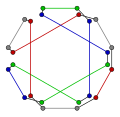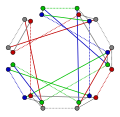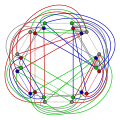|
| This article is rated Start-class on Wikipedia's
content assessment scale. It is of interest to the following WikiProjects: | ||||||||||
| |||||||||||
In case it interests anyone, first, the zig-zag product of a 4-regular graph and of a 1-regular graph, detailed in four steps:
Then the less trivial zig-zag product of a 4-regular graph and of a 2-regular graph, in the four same steps:
Finally, a schema with the principle (same notation as in the formulas):
Hey! There is something wrong with the definition given in the article. For example ROT_H(a,i) is not defined! Surely it should be ROT_H(a,j)!! I have not checked the rest of the definition. — Preceding unsigned comment added by 142.58.10.135 ( talk) 01:43, 12 December 2015 (UTC)
Best, --
MathsPoetry (
talk)
16:56, 3 July 2013 (UTC)
- I think the schema illustration, at least, would be a very helpful addition to the article. —
David Eppstein (
talk)
22:19, 4 July 2013 (UTC)
- Thank you for this mark of appreciation, David. -- MathsPoetry ( talk) 00:20, 5 July 2013 (UTC)
|
| This article is rated Start-class on Wikipedia's
content assessment scale. It is of interest to the following WikiProjects: | ||||||||||
| |||||||||||
In case it interests anyone, first, the zig-zag product of a 4-regular graph and of a 1-regular graph, detailed in four steps:
Then the less trivial zig-zag product of a 4-regular graph and of a 2-regular graph, in the four same steps:
Finally, a schema with the principle (same notation as in the formulas):
Hey! There is something wrong with the definition given in the article. For example ROT_H(a,i) is not defined! Surely it should be ROT_H(a,j)!! I have not checked the rest of the definition. — Preceding unsigned comment added by 142.58.10.135 ( talk) 01:43, 12 December 2015 (UTC)
Best, --
MathsPoetry (
talk)
16:56, 3 July 2013 (UTC)
- I think the schema illustration, at least, would be a very helpful addition to the article. —
David Eppstein (
talk)
22:19, 4 July 2013 (UTC)
- Thank you for this mark of appreciation, David. -- MathsPoetry ( talk) 00:20, 5 July 2013 (UTC)









